Taipei Times: You were a doctor before becoming a politician. Does that experience provide you with a different perspective when tackling governance and interacting with the public?
William Lai (賴清德): There are three “spirits,” so to speak, that I adhere to in my role as a mayor when implementing governance.
First of all are the Democratic Progressive Party’s (DPP) founding principles of “integrity, diligent government and love of country.”
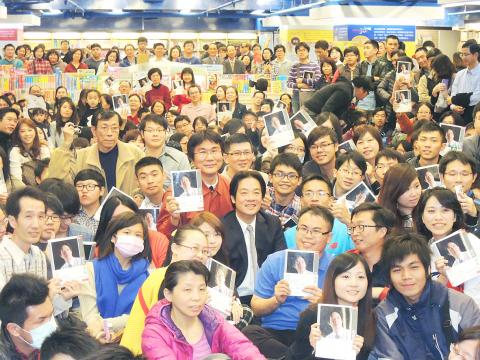
Photo: Tsai Wen-chu, Taipei Times
Second, the “spirit of medicine,” and third, the “spirit of [Angus] MacGyver” [the protagonist of US television series MacGyver, who is known as a problem solver]. Despite difficult circumstances, MacGyver is always able to solve problems at crunch time by pulling together existing resources, with creativity and ingenuity. It’s a mindset different from one that otherwise always asks for money and personnel whenever a problem arises and cites the lack of them as an excuse for inaction.
As for the “spirit of medicine,” my past experience as a physician certainly has been helpful in my political career. When you are ill, you have to seek out the right type of doctor; the sickness could be said to be halfway cured when you find the right kind of doctor. For instance, if I am a nephrologist, someone who has cardiac problems should then visit cardiologist for treatment and not me, who would not have the expertise in treating heart disease as a cardiologist does.
Having trained as a physician, I adhere to the adage that “prevention is better than cure.” Such a mindset drives me to regard the city as an organic entity and treat it as if it were a human being, which means we approach issues by making a diagnosis first and find out what problems there may be, as in the case of the merger of Tainan city and Tainan county; then solve problems by proposing appropriate measures. That’s how the city progresses.
TT: In the book you recently published, you mention the term “Tainan brand” through which you have largely enhanced the city’s visibility. What exactly is the “Tainan brand”?
Lai: To do marketing, you must first have a brand. By having a brand, there can then be a representation, and therefore a “self-awareness” to allow for successful marketing. So we first market the name “Tainan.”
For instance, take the buses in Tainan. There used to be three bus companies — Sinying, Kaohisung and Singnan. We have integrated them all to be called Greater Tainan buses. It fosters a sense of identification among the Tainan residents, which then translates into support.
TT: What lies at the core of the “Tainan brand”?
Lai: Culture is the core of the “Tainan brand.” Tainan is Taiwan’s first city and has in its possession the richest cultural and historical assets, an aspect that’s incomparable with other cities and counties. In the past four years, of course, we’ve employed special approaches in all the various arenas to allow for the best effects, but without a doubt, at the core of the content is culture. Particularly so in light of globalization and the competition it brings, culture is the root; if you don’t have strong roots, you will be swept into oblivion by the tidal wave of international competition. When we strengthen our roots, technology acts as our wings.
TT: You have said that “without roots, there’s no culture” and “without the local, there’s no international.” With culture as the cornerstone in your governance of the city, how then do you link it to the aspects of pro-localization education and Taiwanese identity, and highlight Taiwan’s values via the promotion of Tainan’s culture?
Lai: There are several aspects in answering that question. First, marketing Tainan, from local to international. Let’s take a product as an example. HTC Corp spent big bucks to have Robert Downey Jr in its commercial, yet all it advertised was just “HTC (hold this cat)” [among other words Downey said “HTC” could stand for], without including any element of Taiwanese culture. Then you look at South Korean Samsung’s commercial, one where it featured [South Korean star] Kim Soo-hyun biking past a pair of wings that reflected Korean culture. Taking advertisements of luxury goods such as French bags or French perfume as another example, when you watch these commercials, you can tell they are advertising French products, and so on. Highlighting a culture’s “localness” does not mean airing a political view, for it is also a very important element in economic development and product marketing.
When we visit places around Taiwan or cities overseas, if I don’t talk about Tainan’s culture, it’s like our feet are prevented from stepping any further.
Second, in terms of the cultural connotation, Tainan has a mission — which is to build Tainan as Taiwan’s cultural capital and allow people who set foot in Tainan to feel like they have visited Taiwan as a whole, thereby fostering a sense of pride among Tainan residents, which Taiwanese can identify with, hence the possibility of unifying Taiwan.
I have this thought because when we were little, in classes we were required to memorize places such as [China’s] Yangtze River and the Yellow River, without learning anything about our own Jhuoshuei River (濁水溪) or Tsengwen River (曾文溪). We learnt by heart what goods are the products of which provinces in China, but we were not taught where Tainan’s water chestnut or Yunlin’s water melons came from. This is absurd.
Therefore, we must develop Tainan into a cultural capital to allow people to know about Taiwan, and mold a sense of identity people can identify with.
To do so, we approach the historical aspect in depth and culture in all its breadth. In terms of historical depth, there is the Tsailiao Fossil Museum in [Tainan’s] Zuozhen District (左鎮), where the fossils on display originated locally, including that of a woolly mammoth and Rhinocerossinensis hayasakai and various animals, as well as fossils of human skulls, which date back about 20,000 or 30,000 years ago. Then there is an archeological site in Sinshih (新市) that dates back to between 5,000 and 7,000 years ago. If one visits Anping District (安平), one can see the Eternal Golden Castle (億載金城), Anping Fort (安平古堡), Chihkan Tower (赤嵌樓) and all the historical sites. Then, there is the National Museum of History in Annan District (安南), which displays the history of ordinary people’s ways of living back then. All these show the depth of Tainan’s history.
Tainan’s culture is also broad. For example, the four major religions in Taiwan all started out in Tainan in their early days. Kaiyuan Monastery (開元寺), Buddhism’s first temple in Taiwan, is in the North District; the first church was the SinLau Hospital’s affiliated church; the first Catholic church is in Houbi (後壁); and the first Daoist temple, honoring [one of the most revered Taoist deities] the Heavenly Upper Emperor (玄天上帝), is also in Tainan.
Aside from all these, we also undertake systematic planning to repair and restore historical sites and historical architecture, and cooperate with the private sector in promoting the revitalization of old houses. We also use these historical and cultural elements to promote the development of cultural innovation.
TT: You’ve previously announced an initiative to push the English language as Tainan’s second official language. What concrete steps are being taken toward realizing this goal?
Lai: Culture is our root, and the English language is our tool, or see it as our foot, if you will. Given that language is the primary tool of communication, a lack of English proficiency hampers one from gaining an advantageous position in international competitiveness.
With culture as our roots and technology as our wings, we also need to be equipped with English proficiency to stay competitive. We’ve brought up this idea with the central government, which responded by saying there are difficulties [in implementing this policy]. Since Tainan was Taiwan’s first city and in the early days the door to the outside world, we are willing to take the initiative, in the span of a 10-year plan, to develop Tainan into the first city [in Taiwan] that uses English as its second official language.
To actualize this goal, first we will work to build an English-friendly environment in the city.
Second, we are contemplating the idea of, as a start, designating a school where a selected number of classes would all be taught in English. Aside from providing assistance to the private sector in enhancing English skills, the city government’s civic servants also ought be in step with the plan as well by working to polish their English proficiency.
Government documents are another area of focus. Right now, for example, government-issued certificates and contracts are in both Chinese and English, whereas in the past, they were in Chinese only.
It is the hope that after 10 years, Tainan city councilors will be able to question the mayor in English.
Part two of this interview will be published tomorrow.
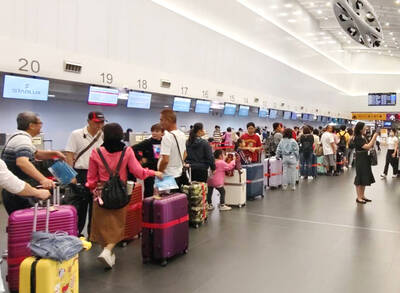
Three Taiwanese airlines have prohibited passengers from packing Bluetooth earbuds and their charger cases in checked luggage. EVA Air and Uni Air said that Bluetooth earbuds and charger cases are categorized as portable electronic devices, which should be switched off if they are placed in checked luggage based on international aviation safety regulations. They must not be in standby or sleep mode. However, as charging would continue when earbuds are placed in the charger cases, which would contravene international aviation regulations, their cases must be carried as hand luggage, they said. Tigerair Taiwan said that earbud charger cases are equipped
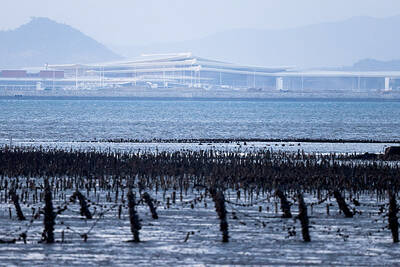
UNILATERAL MOVES: Officials have raised concerns that Beijing could try to exert economic control over Kinmen in a key development plan next year The Civil Aviation Administration (CAA) yesterday said that China has so far failed to provide any information about a new airport expected to open next year that is less than 10km from a Taiwanese airport, raising flight safety concerns. Xiamen Xiangan International Airport is only about 3km at its closest point from the islands in Kinmen County — the scene of on-off fighting during the Cold War — and construction work can be seen and heard clearly from the Taiwan side. In a written statement sent to Reuters, the CAA said that airports close to each other need detailed advanced
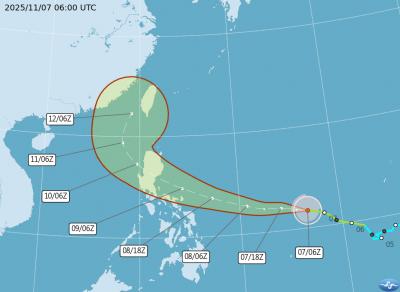
Tropical Storm Fung-Wong would likely strengthen into a typhoon later today as it continues moving westward across the Pacific before heading in Taiwan’s direction next week, the Central Weather Administration (CWA) said. As of 8am, Fung-Wong was about 2,190km east-southeast of Cape Oluanpi (鵝鑾鼻), Taiwan’s southernmost point, moving westward at 25kph and possibly accelerating to 31kph, CWA data showed. The tropical storm is currently over waters east of the Philippines and still far from Taiwan, CWA forecaster Tseng Chao-cheng (曾昭誠) said, adding that it could likely strengthen into a typhoon later in the day. It is forecast to reach the South China Sea
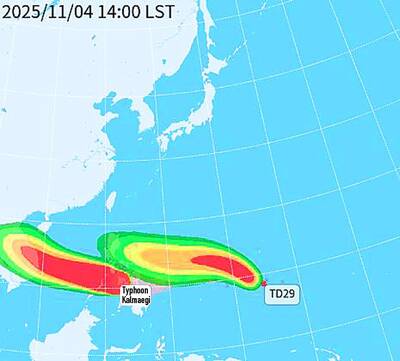
WEATHER Typhoon forming: CWA A tropical depression is expected to form into a typhoon as early as today, the Central Weather Administration (CWA) said yesterday, adding that the storm’s path remains uncertain. Before the weekend, it would move toward the Philippines, the agency said. Some time around Monday next week, it might reach a turning point, either veering north toward waters east of Taiwan or continuing westward across the Philippines, the CWA said. Meanwhile, the eye of Typhoon Kalmaegi was 1,310km south-southeast of Oluanpi (鵝鑾鼻), Taiwan’s southernmost point, as of 2am yesterday, it said. The storm is forecast to move through central